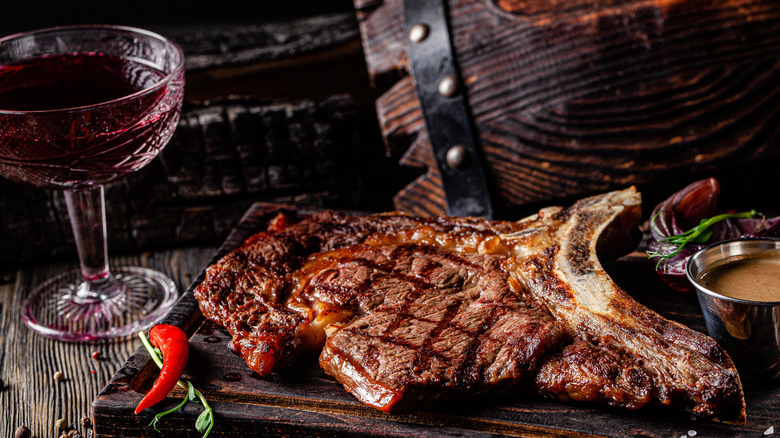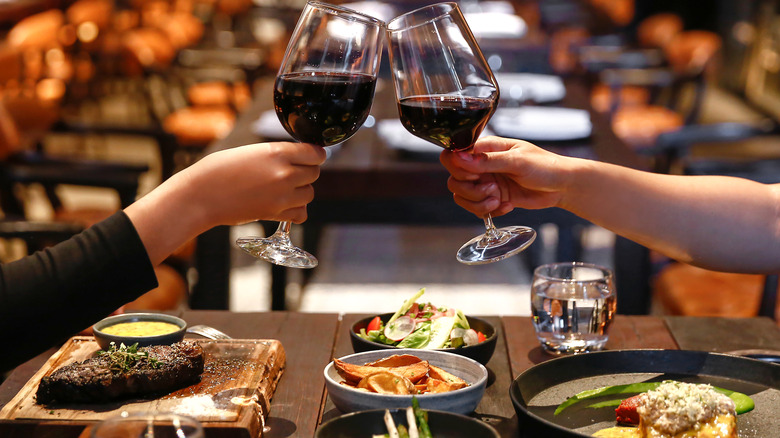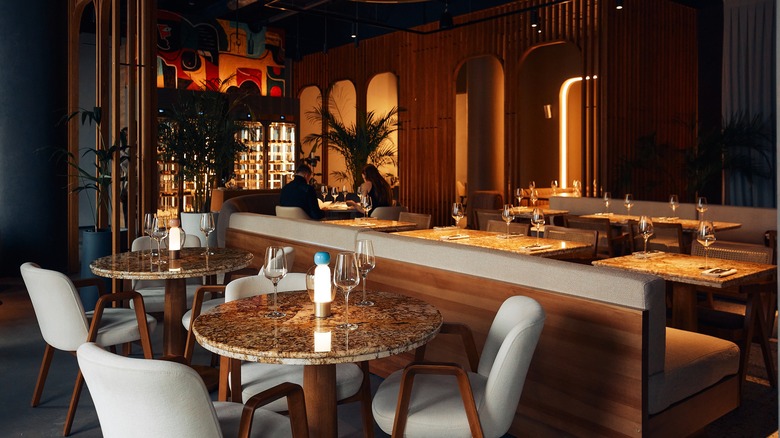Ever Ask Yourself Why Steakhouses Are So Dark?
As lovely as the atmosphere can feel when you walk into a dimly-lit steakhouse, the drawbacks become obvious once you peruse the menu — you might feel like you need some kind of superpower to read unassisted. On the other hand, no one wants to eat ultra-expensive kobe from one of the oldest steakhouses in America under the kind of bright lighting you'd expect from a cafeteria. Steakhouses clearly have to strike a balance, and while they sometimes miss the mark, there are several reasons why they might keep the lights turned down low.
Some sources cite evidence that diners eat higher-calorie foods in a greater quantities in a low light setting. This might give you a propensity to order extra appetizers for the table; more side dishes than you could possibly finish; and a decadent dessert to finish the meal — which obviously bodes well for the profit margins of the steakhouse. The lights might also be dimmed just to give off a posh and romantic vibe that customers expect from such a restaurant. After all, while the shadows might be cumbersome to some guests, that moody darkness might be just right for others.
On a less fanciful note, a lack of illumination may be due to financial constraints for the restaurant. Given the notoriously high costs of running a steakhouse, allocating a significant portion of the budget to lighting may not be worth it for some managers. The result could be a steakhouse that is oddly dark inside.
Does the lighting in a restaurant affect how much you eat?
If it's true that dim lighting makes customers eat more, it would be easy to say steakhouses make this aesthetic choice purely for profit. However, there is conflicting research in regards to how diners can be influenced by the light settings. According to a 2016 study printed in the Journal of Marketing Research, participants who dined in dimly-lit spaces generally chose less nutritious options for their meals. Meals ordered by diners in a darker setting also contained almost 39% more calories, compared to those ordered by participants dining in bright light.
However, research from Cornell University published in 2012 in the Psychological Reports journal offers a contrasting view. In a dining environment with soft lighting and low music, people actually ate fewer calories than when they dined in a brightly-lit setting. Diners also indicated a higher rate of satisfaction after eating in lower lighting. This finding perhaps has more to do with the right amount of dimness creating a vibe that is intimate and comfortable, rather than equating darkness to higher satisfaction.
According to Healthline, when people eat slowly — as they might in a relaxed steakhouse, where you want to savor the experience — they get full faster and consequently eat less. While steakhouses are clearly invested in guests ordering multiple courses of rich, creamy, and indulgent dishes, they might also want the environment to be cozy and comfortable, even if it possibly influences diner to get full faster.
Dim lighting also conveys a luxurious environment
Science aside, low lighting has a connotation of a fashionable, high-class eatery, but the practice isn't as old as you might think. In the early 20th century, a brightly-lit environment was a must for restaurants that wanted to appear high-quality and safe to eat at. It was a way for establishments to call attention to their cleanliness (you can imagine how dim lights might hide poor hygenic practices). However, in a total flip from today's norm, night clubs also used bright lighting when they become popular around the same time period.
In an effort to differentiate themselves from these wild clubs, as well as run-off-the-mill restaurants, high-end eateries began using dimmer lighting. The relationship between fancy restaurants and low light seems to have stuck, though it feels ironic when we recall that it can also be a cost-cutting move. And in an attempt to convey luxury, restaurants can lean into the darkness a little too hard, and create an environment that is particularly difficult for anyone with visual impairments.
Menus can be challenging to read in a shady steakhouse, and all the effort that went into plating a beautiful meal at one of the best steakhouses in New York City might be harder to appreciate for some diners. However, with the prevailing schools of thought on consumer behavior, it is obvious that steakhouses — with their dark wood, cushy booths, ritzy clientele, and decadent menus — will likely continue keeping the lights down low.



